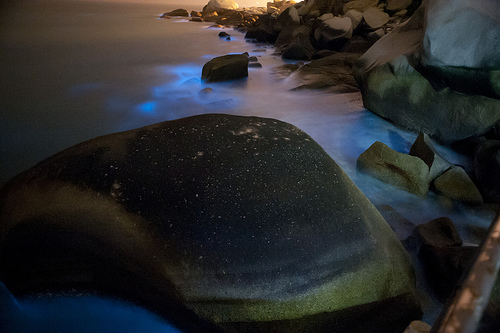Reproduction
 Noctiluca scintillans is a bioluminescent dinoflagellate.
They are one of the few organisms that can reproduce sexually by
producing isogametes or asexually via binary fission. (Fukuda
and Endoh 2006). Being able to reproduce both sexually and
asexually is a huge advantage to an organism. There are both
pros and cons to reproducing sexually as there are for
reproducing asexually. Because Noctiluca scintillans
are able to reproduce either way, they can maximize the amount
of offspring they have. In times when the
environment is stable,
they can reproduce by binary fission and create offspring that
are genetically identical. This is much more efficient than
reproducing sexually and works well most of the time. However,
if the environment is unstable, Noctiluca scintillans
can reproduce sexually and introduce different alleles into the
population that may be better adapted to a changing environment.
Noctiluca scintillans is a bioluminescent dinoflagellate.
They are one of the few organisms that can reproduce sexually by
producing isogametes or asexually via binary fission. (Fukuda
and Endoh 2006). Being able to reproduce both sexually and
asexually is a huge advantage to an organism. There are both
pros and cons to reproducing sexually as there are for
reproducing asexually. Because Noctiluca scintillans
are able to reproduce either way, they can maximize the amount
of offspring they have. In times when the
environment is stable,
they can reproduce by binary fission and create offspring that
are genetically identical. This is much more efficient than
reproducing sexually and works well most of the time. However,
if the environment is unstable, Noctiluca scintillans
can reproduce sexually and introduce different alleles into the
population that may be better adapted to a changing environment.
A study looking at Noctiluca scintillans
off the Gulf of Thailand showed that sexual reproduction only
occurred during a southwest monsoon (Sriwoon et al. 2008).
During the monsoon, Nociluca scintillans almost always
switched from reproducing asexually to reproducing sexually.
This study supported the theory that this organism will
reproduce sexually only in an unstable environment.
Noctiluca scintillans usually only
reproduce asexually through binary fission, but will produce
sexually in a changing environment. When producing sexually,
Noctiluca scintillans produces isogametes (Fukuda and Endoh
2006). These are gametes that are similar in size and shape, but
differ in allele frequencies. With isogametes there is no male
or female gamete. Isogametes are haploid while the adult cell is
diploid. During sexual reproduction, there are two haploid
isogametes each with two flagella. These then form one diploid
zygote with four flagella and as the zygote grows and becomes a
trophont, the amount of flagella begins to decrease and the
tentacle begins to form. In the final stage, the Noctiluca
scintillans is a diploid organism with one flagella and one
tentacle (Fukuda and Endoh 2006).
 Cell reproduction generally occurs in the springtime when
water temperatures are above 5-6° C (Sahling and Uhlig 1990).
Noctiluca scintillans can have huge blooms during
reproduction and cause red tides. Noctiluca scintillans
are often blamed for the death of fish during these blooms. They
themselves are not toxic, but can have a build up of
ammonia
that is released during these red tides and may be the reason
behind the increase in
fish mortality during these
blooms
(Turkoglu 2013).
Cell reproduction generally occurs in the springtime when
water temperatures are above 5-6° C (Sahling and Uhlig 1990).
Noctiluca scintillans can have huge blooms during
reproduction and cause red tides. Noctiluca scintillans
are often blamed for the death of fish during these blooms. They
themselves are not toxic, but can have a build up of
ammonia
that is released during these red tides and may be the reason
behind the increase in
fish mortality during these
blooms
(Turkoglu 2013).
Reproduction was fascinating, and now you can move onto learning
about the
Interactions of Noctiluca scintillans with other species. If
you would like to start fresh on this webpage, please visit the
Homepage.